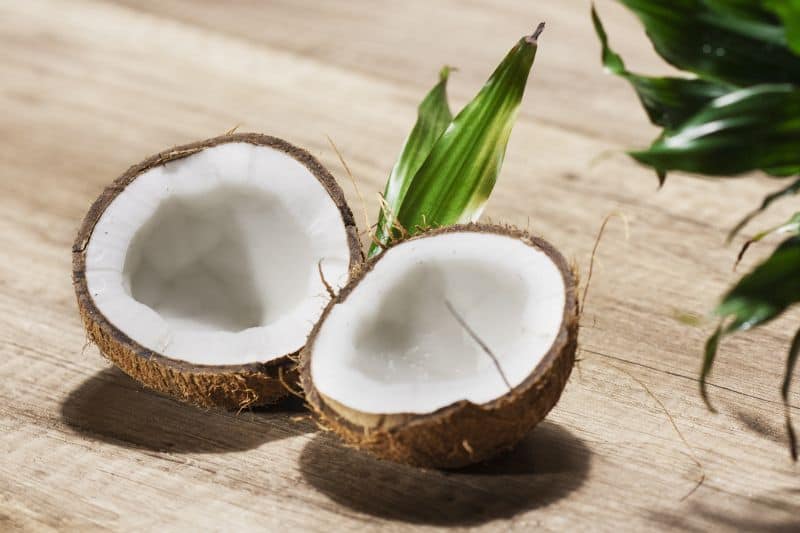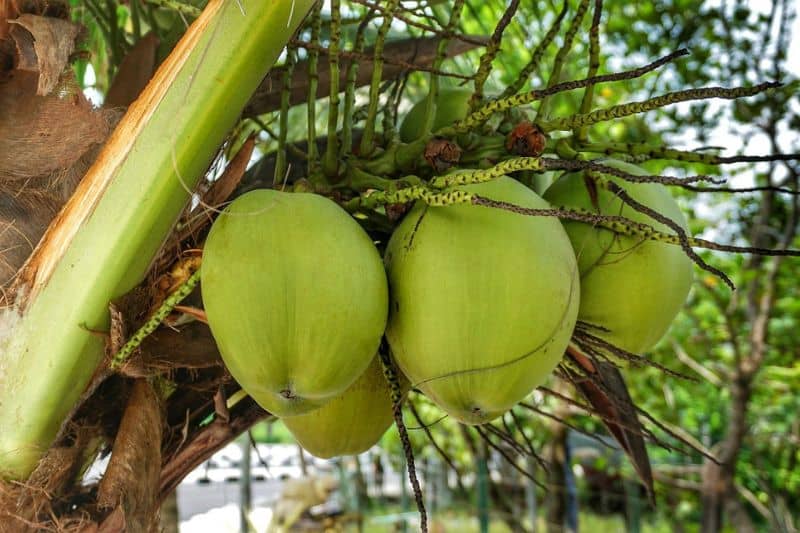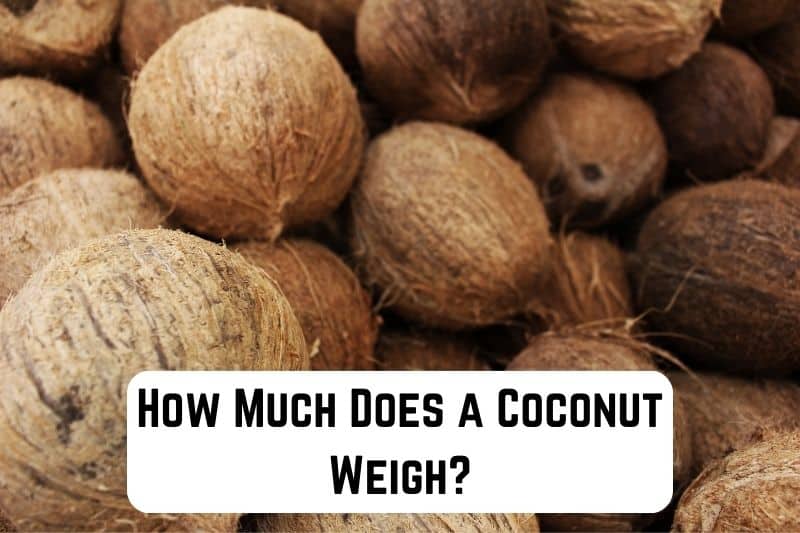If you’ve ever strolled through a tropical destination or even your local grocery store, you’ve likely encountered coconuts and wondered how much a coconut weighs. As the star ingredient of many delicious foods and drinks, coconuts have an unmistakable presence and value.
When it comes to their weight, you might be surprised by the range they can fall into.
As you may know, coconuts come in various shapes and sizes, which means their weight can vary quite a bit. You’ll find that a coconut’s weight is largely dependent on factors such as its age, size, and the specific type of coconut palm it grows on.
Let’s dive into some of the most common types of coconuts and see what factors impact their weight.
Read: How Much Does a Gallon of Propane Weigh? (Propane Weight Chart)
A mature coconut weighs around 1.2 kg to 2 kg (2.6 lbs to 4.4 lbs). However, the actual weight can vary depending on the size and maturity of the individual coconut. Young coconuts, which have a green outer shell, tend to be lighter, with an average weight of about 0.9 kg (2 lbs).
How Much Does a Coconut Weigh?

A mature coconut weighs around 1.2 kg to 2 kg (2.6 lbs to 4.4 lbs). However, the actual weight can vary depending on the size and maturity of the individual coconut. Young coconuts, which have a green outer shell, tend to be lighter, with an average weight of about 0.9 kg (2 lbs).
It’s important to note that the different layers of a coconut contribute to its overall weight. Here’s an approximate breakdown of a coconut’s layers for a better understanding:
- Husk: 300g to 500g (10.6 oz to 17 oz)
- Shell: 500g to 1kg (17 oz to 35.3 oz)
- Water: 340g (12 oz)
- Meat: 50-150g (1.8-5.3 oz)
Keep in mind that these numbers are for a typical mature coconut. Young coconuts usually have less meat and more water, while mature coconuts have a thicker layer of meat.
A coconut’s weight can also be influenced by factors such as the variety of the coconut and the environment in which the coconut tree grows. For example, certain types of coconuts, such as the dwarf coconut, are smaller and lighter than the more common tall coconut varieties.
Determining Coconut Weight
Size and Stage of Growth
When determining the weight of a coconut, it’s essential to consider its size and stage of growth. As a coconut matures, its weight can vary significantly.
For instance, a young, green coconut might only weigh around 2 lbs (0.9 kg), while a mature, brown coconut can weigh up to 4.4 lbs (2 kg) or more. Additionally, remember that the type of coconut can also impact its weight.
Dehusked vs Husked Weight

Another crucial factor when weighing coconuts is whether or not they are dehusked. A coconut with its husk still intact will, of course, weigh more than a dehusked one.
Consequently, estimating the weight of a coconut based solely on its appearance might be inaccurate.
For example, consider a brown, mature coconut with a husk:
- With husk: approximately 4.4 lbs (2 kg)
- Without husk: approximately 2.6 lbs (1.2 kg)
As you can see, the difference in weight between a husked and dehusked coconut can be quite significant. By taking into account the size, stage of growth, and whether a coconut is husked or dehusked, you’ll be well-equipped to estimate its weight more accurately.
Factors Influencing Coconut Weight

Geographical Factors
When it comes to the weight of a coconut, you have to consider the geographical factors that play a significant role. Coconut palms typically grow in tropical and subtropical regions, where the climate, soil, and sunlight can greatly affect the size and weight of the fruit.
For example, the amount of rainfall and the type of soil in a region can influence the availability of nutrients for the tree.
You will likely find larger and heavier coconuts in areas with fertile soil and ample rainfall. On the other hand, regions with poor soil quality and limited water supply might result in smaller and lighter coconuts.
Moreover, the temperature and sunlight exposure can also impact the tree’s overall growth, subsequently affecting the weight and size of the fruit.
Cultivation Practices
Besides geographical factors, cultivation practices play an essential role in determining the weight of a coconut. Some of these factors include:
- Variety of coconut palms: There are various varieties of coconut palms, each of which produces coconuts with different attributes. Some varieties may yield larger and heavier fruit, while others might produce smaller and lighter ones. It’s important for you to be aware of the type of coconut palm cultivated in your area, as that will directly impact the weight and size of coconuts you encounter.
- Planting density: The spacing between planted coconut palms can influence the weight of a coconut. Higher planting densities can result in competition for resources like water, sunlight, and nutrients, which may translate to lighter coconuts. On the other hand, wider spacing can lead to an overall increase in fruit size and weight.
- Fertilization and irrigation: Proper management of fertilization and irrigation systems can considerably affect coconut weight. Applying appropriate nutrient mixtures and timely watering can encourage the growth of larger and heavier coconuts.
- Pest and disease control: Pests and diseases can stunt the growth of coconut palms, leading to a decrease in fruit size and weight. Implementing proper pest and disease control measures is crucial to maintain the tree’s health and ensure the production of larger and heavier coconuts.
By understanding these factors, you can better appreciate the various influences on the weight of coconuts across different regions and cultivation styles.
Uses of Coconuts Based on Weight

When dealing with coconuts, their weight can significantly affect how you use them. Let’s explore the different uses of coconuts based on their weight and how they could affect your daily life.
Read: How Much Does a Gallon of Diesel Fuel Weigh? (Comparison With Other Fuels)
Lightweight Coconuts
A lighter coconut, weighing around 1-2 pounds, is perfect for snacking on the go. You can easily carry it around and enjoy its refreshing water and soft meat. Additionally, lightweight coconuts are perfect for making:
- Coconut milk (the meat will be easier to handle and blend)
- Young coconut salads (as they have a tender texture)
- Impressive cocktail garnishes (their smaller size fits well in a glass)
Medium-weight Coconuts
Medium-weight coconuts, usually between 2-4 pounds, provide more meat and water, making them ideal for:
- Freshly grated coconut, which you can use in various recipes like coconut rice or add to baked goods
- Homemade coconut oil (just make sure you have enough good-quality meat)
- Tasty and nutritious coconut smoothies (you’ll get more water to blend with your favorite fruits)
Heavyweight Coconuts
Lastly, if you come across a heavyweight coconut, weighing over 4 pounds, you can use it for:
- Shredded coconut (its meat will have a firmer texture, suitable for shredding)
- Coconut flour (by drying and grinding the meat)
- Allowing it to continue maturing until it develops a thick husk, which can be used for crafts such as bowls, cups, and other decorative items
Overall, knowing the weight of the coconuts at your disposal opens up a world of possibilities. So, next time you find yourself with a coconut, consider its weight and let your culinary creativity run wild!







